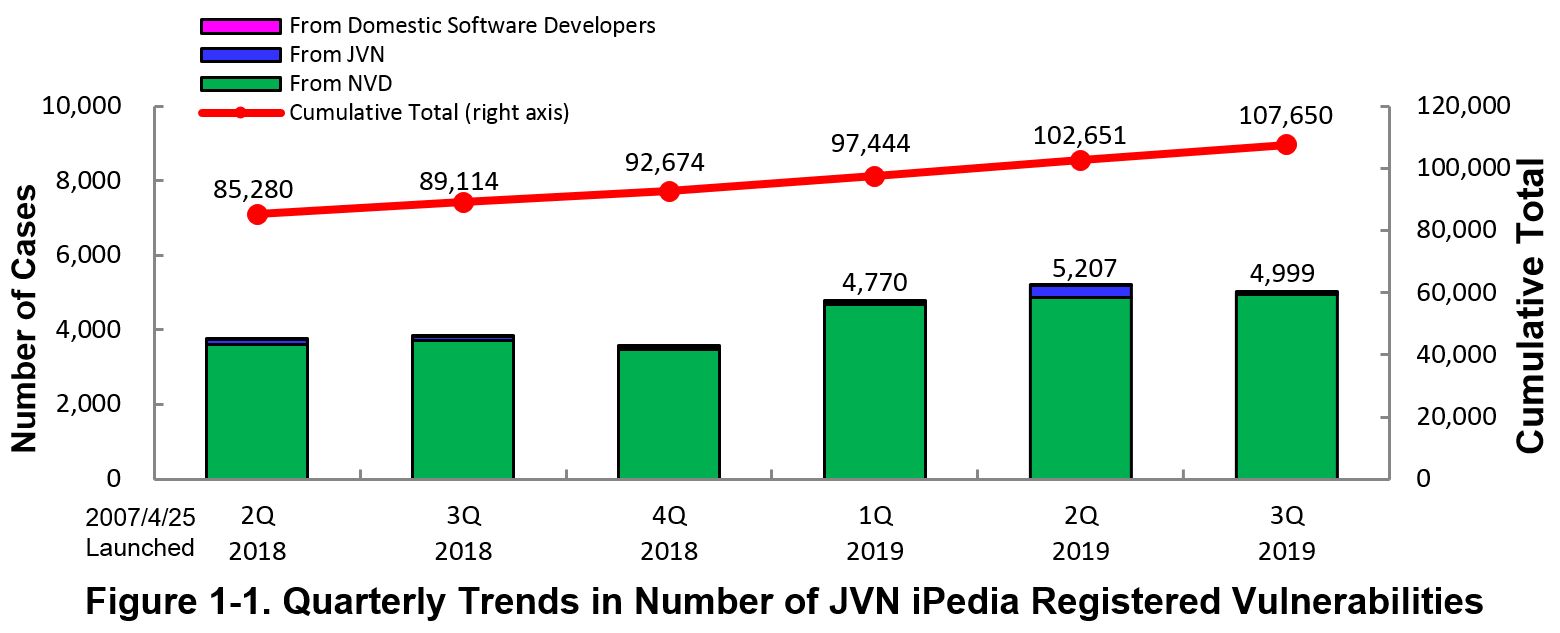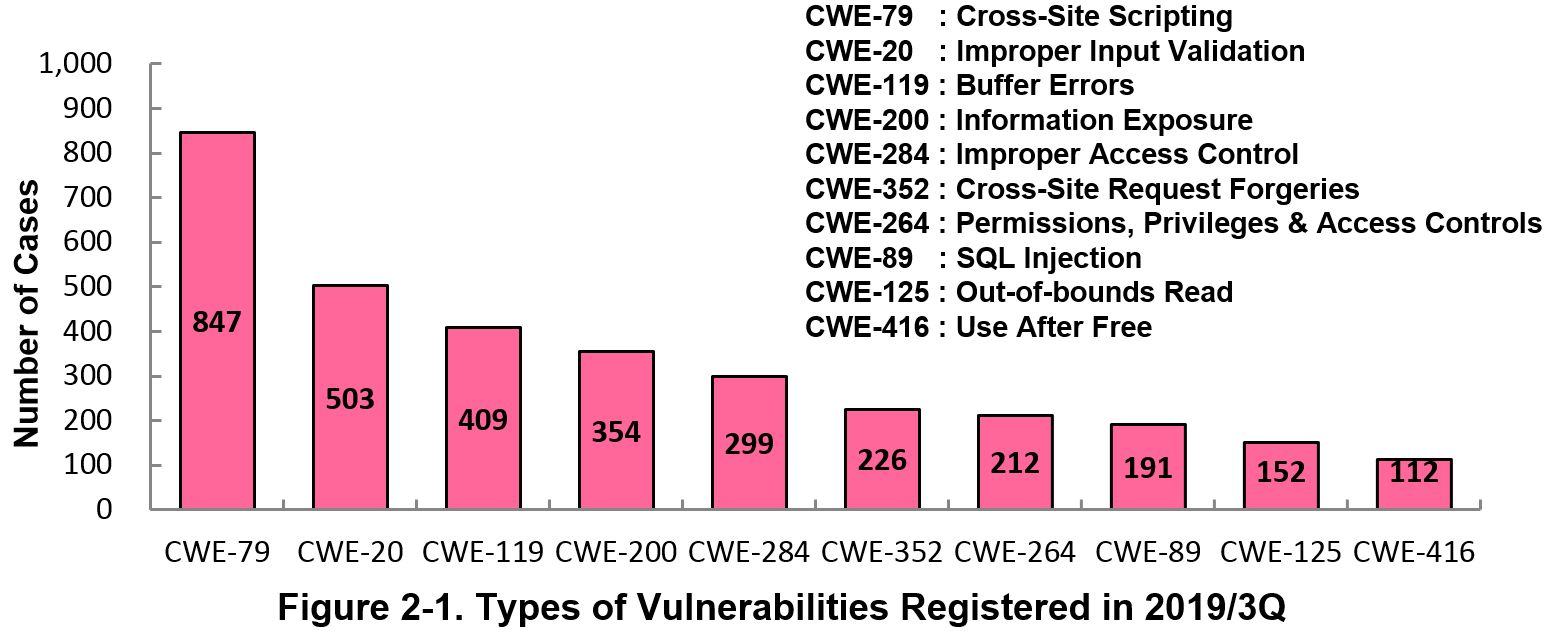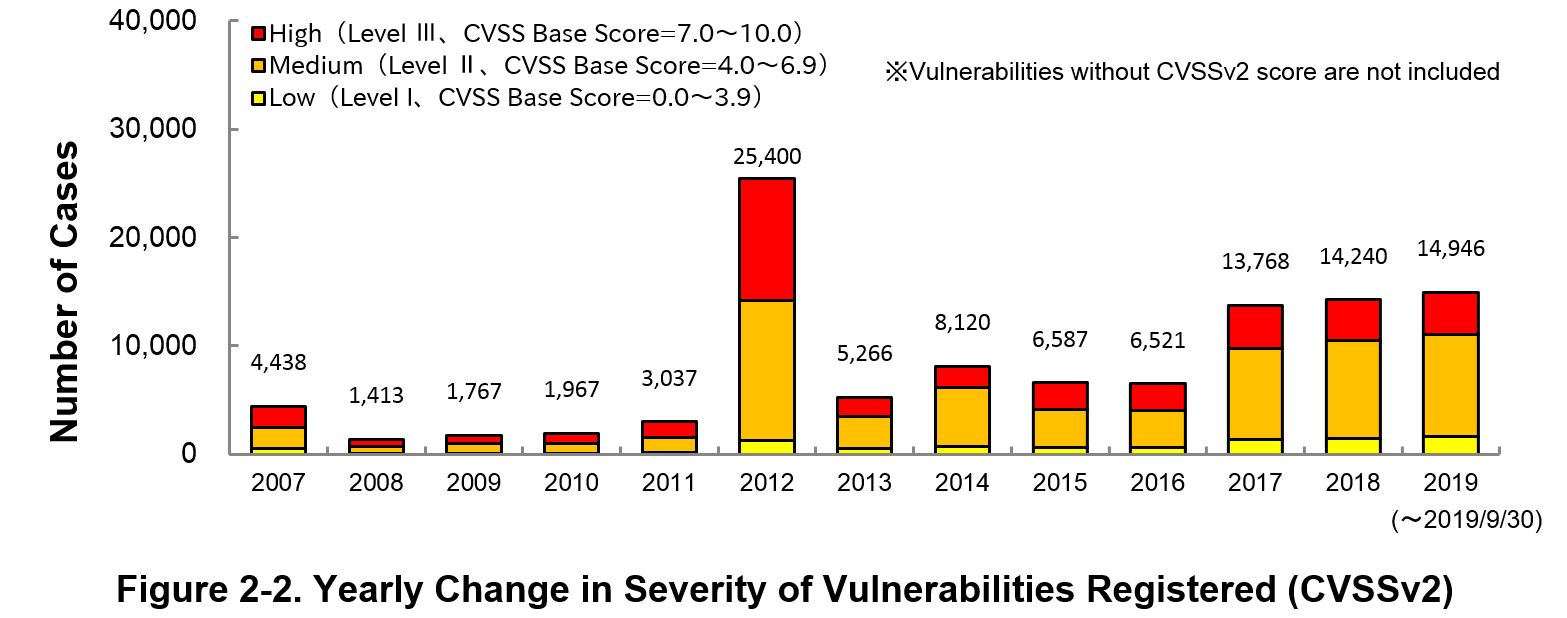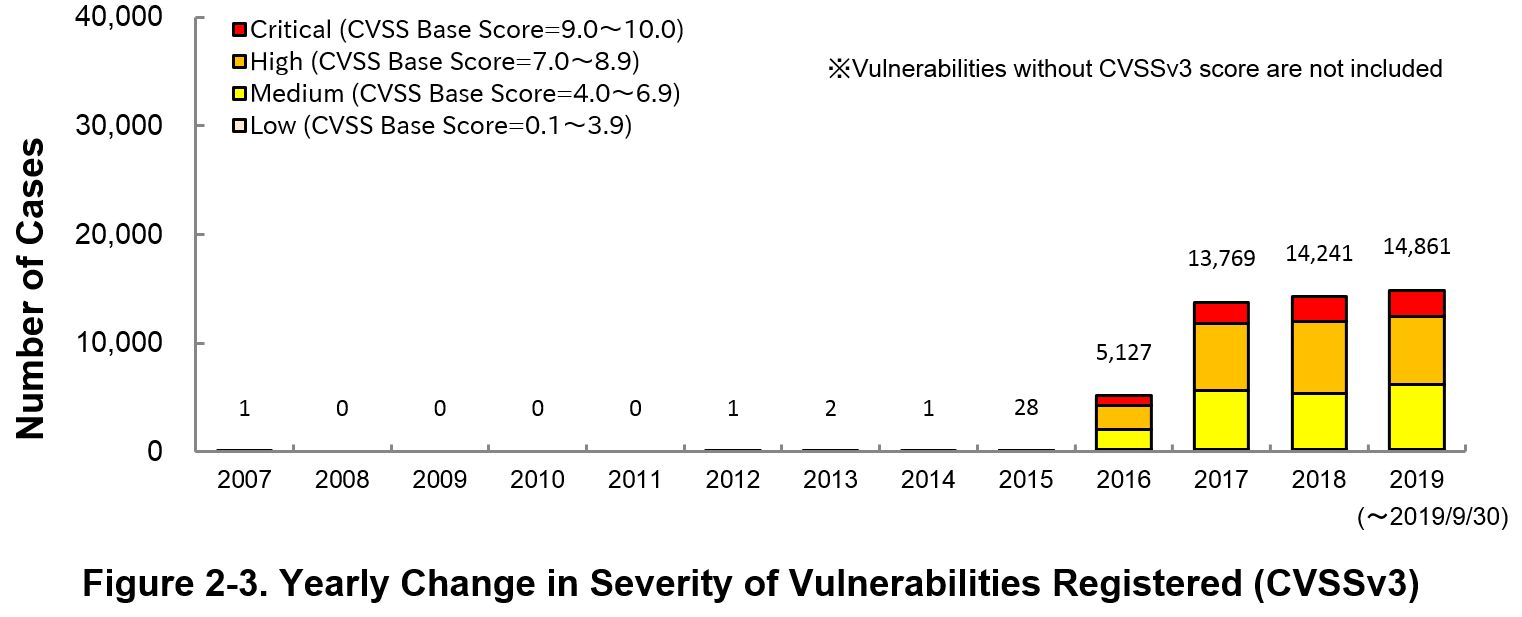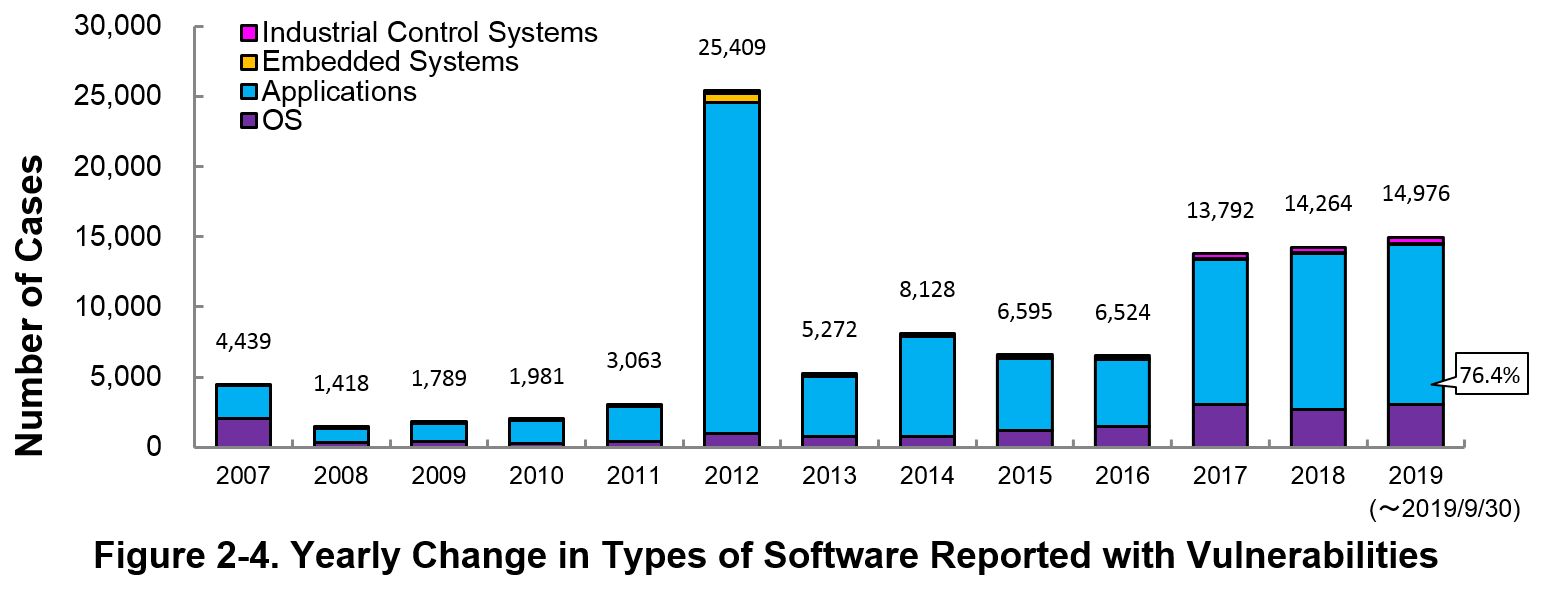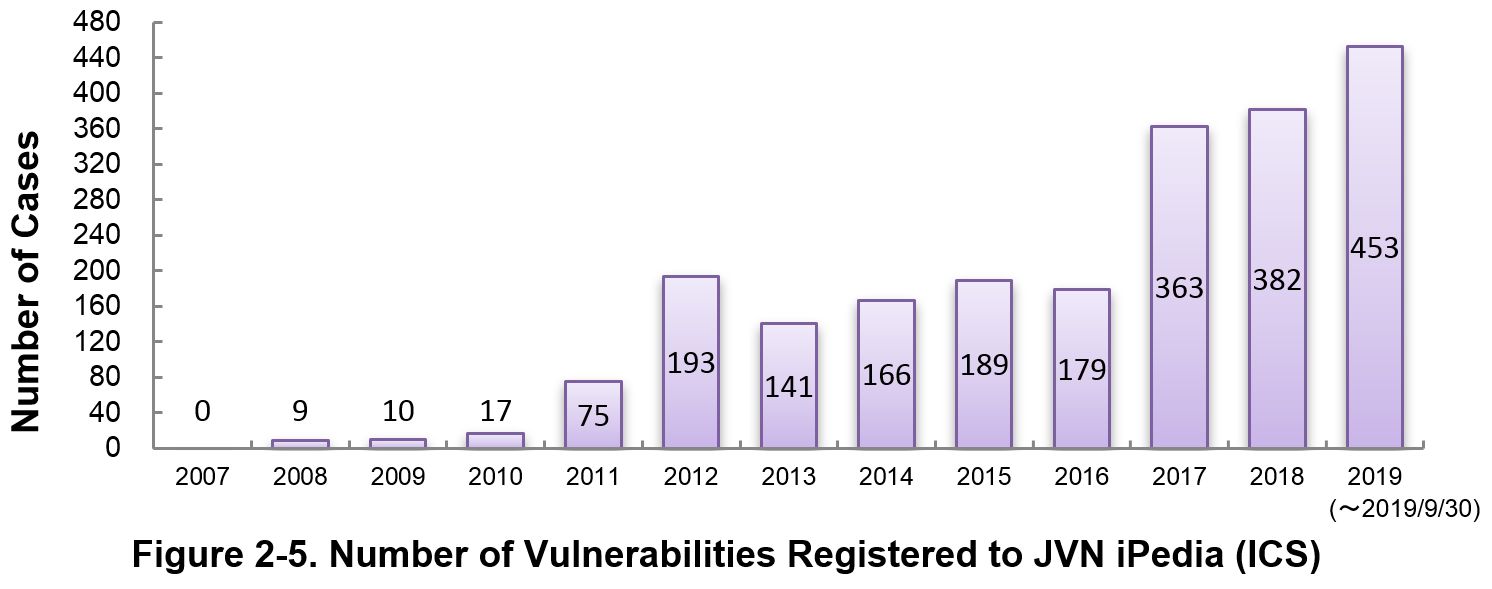Enhancing information security

Vulnerability Countermeasure Information Database JVN iPedia Registration Status [2019 3rd Quarter (Jul. - Sep.)]
Release Date:Nov 20, 2019
IT Security Center
1. 2019 3rd Quarter: Vulnerability Countermeasure Information Database JVN iPedia Registration Status
The vulnerability countermeasure information database JVN iPedia (https://jvndb.jvn.jp/en/) is endeavoring to become a comprehensive vulnerability database where vulnerability information is aggregated for easy access for IT users. JVN iPedia collects and/or translates the vulnerability information published by 1) domestic software developers, 2) JVN (*1), a vulnerability information portal run by JPCERT/CC and IPA, and 3) NVD (*2), a vulnerability database run by NIST (*3). JVN iPedia has been making vulnerability information available to the public since April 25, 2007.
1-1. Vulnerabilities Registered in 2019/3Q
~ JVN iPedia now stores 112,084 vulnerabilities ~
The summary of the vulnerability information registered to the Japanese version of JVN iPedia during the 4th quarter of 2019 (October 1 to December 31, 2019) is shown in the table below. As of the end of December 2019, the total number of vulnerabilities stored in JVN iPedia is 112,084 (Table 1-1, Figure 1-1).
As for the JVN iPedia English version, the total number of vulnerabilities stored is 2,093 as shown in the lower half of the Table 1-1.
Table 1-1. Vulnerabilities Registered to JVN iPedia during 3rd Quarter of 2019
|
|
Information Source
|
Registered Cases
|
Cumulative Cases
|
|---|---|---|---|
|
Japanese Version
|
Domestic Product Developers
|
1 cases
|
219 cases
|
|
JVN
|
74 cases
|
8,746 cases
|
|
|
NVD
|
4,924 cases
|
98,685 cases
|
|
|
Total
|
4,999 cases
|
107,650 cases
|
|
|
English Version
|
Domestic Product Developers
|
1 cases
|
218 cases
|
|
JVN
|
17 cases
|
1,848 cases
|
|
|
Total
|
18 cases
|
2,066 cases
|
2-1. Types of Vulnerabilities Reported
Figure 2-1 shows the number of vulnerabilities newly added to JVN iPedia during the 3rd quarter of 2019, sorted by the CWE vulnerability types.
The type of the vulnerabilities reported most in the 3rd quarter is CWE-79 (Cross-Site Scripting) with 847 cases, followed by CWE-20 (Improper Input Validation) with 503, CWE-119 (Improper Re-striction of Operations within the Bounds of a Memory Buffer (Buffer Errors)) with 409, CWE-200 (Information Exposure) with 354, and CWE-284 (Improper Access Control) with 299.
CWE-79 (Cross-Site Scripting), the most reported vulnerability type in this quarter, could allow attackers to display false webpages and/or steal information.
Software developers need to make sure to mitigate vulnerability from the planning and design phase of software development. IPA provides tools and guidelines, such as "How to Secure Your Website" (*4), "Secure Programing Guide" (*5) and "AppGoat" (*6), a hands-on venerability learning tool, for website developers and operators to build secure websites.
2-2. Severity of Vulnerabilities Reported
Figure 2-2 shows the yearly change in the CVSSv2 rating scale based severity of vulnerabilities registered to JVN iPedia.
As for the vulnerabilities added to JVN iPedia in 2019, 26.3 percent are “Level III”(7.0 - 10.0), 62.8 percent are “Level ll” (4.0 – 6.9) and 10.9 percent are “Level I” (0.0 – 3.9). This means 89.1 percent of all vulnerabilities registered are Level II or higher, which are potentially critical enough to cause damage like information exposure or data falsification.
Figure 2-3 shows the yearly change in the CVSSv3 rating scale based severity of vulnerabilities registered to JVN iPedia.
As for the vulnerabilities added to JVN iPedia in 2019, 16.2 percent are “Critical” (9.0 – 10.0), 42.0 percent are “High” (7.0 – 8.9), 40.5 percent are “Medium” (4.0 – 6.9) and 1.3 percent are “Low” (0.1 – 3.9).
To avoid threats posed by the known vulnerabilities, both product developers and IT users should pay close attention to vulnerability disclosure and update software they use to a fixed version or apply a security patch as soon as possible when they become available. IT users can check vulnerabilities newly published on JVN iPedia in RSS and XML format (*7) as well.
2-3. Types of Software Reported with Vulnerability
Figure 2-4 shows the yearly change in the type of software reported with vulnerability. Application vulnerabilities have been published most, accounting for 76.4 percent (11,444 out of 14,976) of the 2019 total.
Figure 2-5 shows the yearly change in the number of JVN iPedia-stored vulnerabilities in industrial control systems (ICS) used in critical infrastructure sectors. As of September 2019, the total of 2,177 ICS vulnerabilities have been registered.
2-4. Products Reported with Vulnerability
Table 2-1 lists the top 20 software whose vulnerabilities were most registered to JVN iPedia during the 3rd quarter (July to September) of 2019.
In this quarter, server management software ‘cPanel’ is the 1st rank. This doesn't mean that a lot of vulnerabilities of cPanel were found in the 3rd quarter because 286 out of 315 vulnerabilities were already made public in or before 2018. It is thought that those were registered together in NVD which is the information source of JVN iPedia for some reason (e.g., CVE IDs were requested in the 3rd Quarter). From 2nd to 12th, OS products are ranked and most of which are Microsoft Windows products.
Besides those in the top 20 list, JVN iPedia stores and offers vulnerability information about a variety of software. IPA hopes software developers and users will make good use of JVN iPedia to efficiently check vulnerability information and take necessary action in a timely manner (*8).
Table 2-1. Top 20 Software Products Vulnerabilities Were Most Registered [Jul. – Sep. 2019]
|
Rank
|
Category
|
Product Name (Vendor)
|
Number of
Vulnerabilities Registered |
|---|---|---|---|
|
1
|
Server Management Software
|
cPanel (cPanel)
|
315
|
|
2
|
OS
|
Microsoft Windows Server (Microsoft)
|
146
|
|
3
|
OS
|
Microsoft Windows 10 (Microsoft)
|
145
|
|
4
|
OS
|
Microsoft Windows Server 2019 (Microsoft)
|
128
|
|
5
|
OS
|
Microsoft Windows Server 2016 (Microsoft)
|
110
|
|
6
|
OS
|
Linux Kernel (Kernel.org)
|
93
|
|
7
|
OS
|
Microsoft Windows Server 2008 (Microsoft)
|
92
|
|
7
|
OS
|
Microsoft Windows Server 2012 (Microsoft)
|
92
|
|
9
|
OS
|
Microsoft Windows 7 (Microsoft)
|
91
|
|
10
|
OS
|
Microsoft Windows 8.1 (Microsoft)
|
90
|
|
11
|
OS
|
Microsoft Windows RT 8.1 (Microsoft)
|
84
|
|
12
|
OS
|
Android (Google)
|
76
|
|
13
|
PDF Viewer/Editor
|
Adobe Acrobat DC (Adobe Systems)
|
75
|
|
13
|
PDF Viewer
|
Adobe Acrobat Reader DC (Adobe Systems)
|
75
|
|
15
|
Browser
|
Google Chrome (Google)
|
74
|
|
16
|
CMS
|
Magento (Magento, Inc.)
|
71
|
|
17
|
Software Development Platform
|
GitLab (GitLab.org)
|
69
|
|
18
|
OS
|
Debian GNU/Linux (Debian)
|
45
|
|
19
|
Middleware
|
MySQL (Oracle)
|
43
|
|
20
|
Browser
|
Mozilla Firefox (Mozilla Foundation)
|
42
|
3. Most Accessed Vulnerability Countermeasure Information
Table 3-1 lists the top 20 most accessed vulnerability countermeasure information in JVN iPedia during the 3rd quarter of 2019 (July to September).
All the vulnerability countermeasure information ranked top 20 in this quarter are vulnerability countermeasure information released on the Vulnerability Countermeasure Information Portal Site JVN.
Rating Scale
Note 1) CVSSv2 Severity Rating Scale
- Level I (Low)
- CVSS Base Score = 0.0~3.9
- Level II (Medium)
- CVSS Base Score = 4.0~6.9
- Level III (High)
- CVSS Base Score = 7.0~10.0
Note 2) CVSSv3 Severity Rating Scale
- Low
- CVSS Base Score =0.1~3.9
- Medium
- CVSS Base Score =4.0~6.9
- High
- CVSS Base Score =7.0~8.9
- Critical
- CVSS Base Score =9.0~10.0
Table 3-1. Top 20 Most Accessed Vulnerability Countermeasure Information in JVN iPedia [Jul. – Sep. 2019]
No.1 Multiple vulnerabilities in Hikari Denwa router/Home GateWay JVNDB-2019-000043
- CVSSv2 Severity Rating Scale
-
- Level II (Medium)
- CVSSv2 Base Score
-
4.3
- CVSSv3 Severity Rating Scale
-
- Medium
- CVSSv3 Base Score
-
6.1
- Date Public
-
2019/6/27
- Access Count
-
8,313
No.2 Multiple vulnerabilities in Access analysis CGI An-Analyzer JVNDB-2019-000045
- CVSSv2 Severity Rating Scale
-
- Level II (Medium)
- CVSSv2 Base Score
-
6.5
- CVSSv3 Severity Rating Scale
-
Medium
- CVSSv3 Base Score
-
6.3
- Date Public
-
2019/7/5
- Access Count
-
7,390
No.3 The management console of iDoors Reader vulnerable to authentication bypass JVNDB-2019-000044
- CVSSv2 Severity Rating Scale
-
Level II (Medium)
- CVSSv2 Base Score
-
5.8
- CVSSv3 Severity Rating Scale
-
High
- CVSSv3 Base Score
-
8.8
- Date Public
-
2019/7/1
- Access Count
-
6,815
No.4 Multiple vulnerabilities in Panasonic BN-SDWBP3 JVNDB-2018-000122
- CVSSv2 Severity Rating Scale
-
Level II (Medium)
- CVSSv2 Base Score
-
5.8
- CVSSv3 Severity Rating Scale
-
Medium
- CVSSv3 Base Score
-
8.8
- Date Public
-
2018/11/20
- Access Count
-
6,485
No5. Intel Dual Band Wireless-AC 8260 vulnerable to denial-of-service (DoS) JVNDB-2019-000046
- CVSSv2 Severity Rating Scale
-
Level I (Low)
- CVSSv2 Base Score
-
3.3
- CVSSv3 Severity Rating Scale
-
Medium
- CVSSv3 Base Score
-
4.3
- Date Public
-
2019/7/10
- Access Count
-
6,417
No.6 WordPress Plugin "Category Specific RSS feed Subscription" vulnerable to cross-site request forgery JVNDB-2019-000049
- CVSSv2 Severity Rating Scale
-
- Level I (Low)
- CVSSv2 Base Score
-
2.6
- CVSSv3 Severity Rating Scale
-
- Medium
- CVSSv3 Base Score
-
4.3
- Date Public
-
2019/7/18
- Access Count
-
6,327
No.7 WordPress Plugin "WordPress Ultra Simple Paypal Shopping Cart" vulnerable to cross-site request forgery JVNDB-2019-000048
- CVSSv2 Severity Rating Scale
-
- Level I (Low)
- CVSSv2 Base Score
-
2.6
- CVSSv3 Severity Rating Scale
-
Medium
- CVSSv3 Base Score
-
4.3
- Date Public
-
2019/7/16
- Access Count
-
6,039
No.8 Central Dogma vulnerable to cross-site scripting JVNDB-2019-000050
- CVSSv2 Severity Rating Scale
-
Level II (Medium)
- CVSSv2 Base Score
-
4.3
- CVSSv3 Severity Rating Scale
-
Medium
- CVSSv3 Base Score
-
6.1
- Date Public
-
2019/7/31
- Access Count
-
5,857
No.9 Multiple vulnerabilities in FileZen JVNDB-2018-000104
- CVSSv2 Severity Rating Scale
-
Level III (High)
- CVSSv2 Base Score
-
10.0
- CVSSv3 Severity Rating Scale
-
Critical
- CVSSv3 Base Score
-
10.0
- Date Public
-
2018/10/15
- Access Count
-
5,735
No.10 WonderCMS vulnerable to directory traversal JVNDB-2019-007404
- CVSSv2 Severity Rating Scale
-
Level II (Medium)
- CVSSv2 Base Score
-
5.5
- CVSSv3 Severity Rating Scale
-
Medium
- CVSSv3 Base Score
-
6.4
- Date Public
-
2019/8/9
- Access Count
-
5,718
No.11 Metabase vulnerable to cross-site scripting JVNDB-2018-000105
- CVSSv2 Severity Rating Scale
-
- Level II (Medium)
- CVSSv2 Base Score
-
4.3
- CVSSv3 Severity Rating Scale
-
- Medium
- CVSSv3 Base Score
-
6.1
- Date Public
-
2018/10/11
- Access Count
-
5,688
No.12 WordPress plugin "spam-byebye" vulnerable to cross-site scripting JVNDB-2019-000001
- CVSSv2 Severity Rating Scale
-
- Level I (Low)
- CVSSv2 Base Score
-
2.6
- CVSSv3 Severity Rating Scale
-
Medium
- CVSSv3 Base Score
-
6.1
- Date Public
-
2019/1/10
- Access Count
-
5,603
No.13 Installer of ChatWork Desktop App for Windows may insecurely load Dynamic Link Libraries JVNDB-2018-000073
- CVSSv2 Severity Rating Scale
-
Level II (Medium)
- CVSSv2 Base Score
-
6.8
- CVSSv3 Severity Rating Scale
-
High
- CVSSv3 Base Score
-
7.8
- Date Public
-
2018/7/23
- Access Count
-
5,589
No.14 Explzh vulnerable to directory traversal JVNDB-2018-000079
- CVSSv2 Severity Rating Scale
-
Level II (Medium)
- CVSSv2 Base Score
-
4.3
- CVSSv3 Severity Rating Scale
-
Low
- CVSSv3 Base Score
-
3.3
- Date Public
-
2018/7/13
- Access Count
-
5,568
No.15 OpenAM (Open Source Edition) vulnerable to open redirect JVNDB-2019-000007
- CVSSv2 Severity Rating Scale
-
Level I (Low)
- CVSSv2 Base Score
-
2.6
- CVSSv3 Severity Rating Scale
-
Low
- CVSSv3 Base Score
-
3.4
- Date Public
-
2019/2/6
- Access Count
-
5,562
No.16 Multiple vulnerabilities in ORCA(Online Receipt Computer Advantage) JVNDB-2018-000081
- CVSSv2 Severity Rating Scale
-
- Level II (Medium)
- CVSSv2 Base Score
-
5.2
- CVSSv3 Severity Rating Scale
-
- Medium
- CVSSv3 Base Score
-
5.5
- Date Public
-
2018/7/18
- Access Count
-
5,560
No.17 Cybozu Garoon vulnerable to directory traversal JVNDB-2018-000099
- CVSSv2 Severity Rating Scale
-
- Level II (Medium)
- CVSSv2 Base Score
-
5.5
- CVSSv3 Severity Rating Scale
-
Medium
- CVSSv3 Base Score
-
6.4
- Date Public
-
2018/9/10
- Access Count
-
5,525
No.18 Movable Type plugin MTAppjQuery vulnerable to PHP code execution JVNDB-2018-000080
- CVSSv2 Severity Rating Scale
-
Level III (High)
- CVSSv2 Base Score
-
7.5
- CVSSv3 Severity Rating Scale
-
High
- CVSSv3 Base Score
-
7.3
- Date Public
-
2018/7/18
- Access Count
-
5,523
No.19 Multiple vulnerabilities in Toshiba Lighting & Technology Corporation Home gateway JVNDB-2018-000132
- CVSSv2 Severity Rating Scale
-
Level III (High)
- CVSSv2 Base Score
-
8.3
- CVSSv3 Severity Rating Scale
-
High
- CVSSv3 Base Score
-
8.8
- Date Public
-
2018/12/19
- Access Count
-
5,504
No.20 WordPress plugin "FV Flowplayer Video Player" vulnerable to cross-site scripting JVNDB-2018-000078
- CVSSv2 Severity Rating Scale
-
Level I (Low)
- CVSSv2 Base Score
-
2.6
- CVSSv3 Severity Rating Scale
-
Medium
- CVSSv3 Base Score
-
6.1
- Date Public
-
2018/7/17
- Access Count
-
5,494
Table 3-2 lists the top 5 most accessed vulnerability information among those reported by domestic product developers.
Table 3-2. Top 5 Most Accessed Vulnerabilities Reported by Domestic Product Developers [Jul. - Sep. 2019]
No.1 Problem with directory permissions in JP1/Operations Analytics JVNDB-2018-010027
- CVSSv2 Severity Rating Scale
-
Level I (Low)
- CVSSv2 Base Score
-
- 3.5
- CVSSv3 Severity Rating Scale
-
Medium
- CVSSv3 Base Score
-
- 4.9
- Date Public
-
2018/12/4
- Access Count
-
4,191
No.2 Vulnerability in Cosminexus HTTP Server and Hitachi Web Server JVNDB-2019-004441
- CVSSv2 Base Score
-
- -
- CVSSv3 Base Score
-
-
- Date Public
-
2019/6/3
- Access Count
-
4,177
No.3 Multiple Vulnerabilities in Cosminexus JVNDB-2019-002892
- CVSSv2 Base Score
-
-
- CVSSv3 Base Score
-
-
- Date Public
-
2019/4/25
- Access Count
-
4,156
No.4 Multiple Vulnerabilities in JP1/VERITAS JVNDB-2018-009328
- CVSSv2 Severity Rating Scale
-
Level III (High)
- CVSSv2 Base Score
-
10.0
- CVSSv3 Severity Rating Scale
-
Critical
- CVSSv3 Base Score
-
9.8
- Date Public
-
2018/11/15
- Access Count
-
4,084
No.5 DoS Vulnerability in Hitachi IT Operations Director, JP1/IT Desktop Management - Manager and JP1/IT Desktop Management 2 - Manager JVNDB-2019-003539
- CVSSv2 Base Score
-
-
- CVSSv3 Base Score
-
-
- Date Public
-
2019/5/20
- Access Count
-
4,065
Footnotes
-
(*1)
-
(*2)
-
(*3)
-
(*4)
-
(*5)
-
(*6)
-
(*7)
-
(*8)
Past Quarterly Reports
Contact information
IT Security Center, Information-technology Promotion Agency, Japan (ISEC/IPA)

